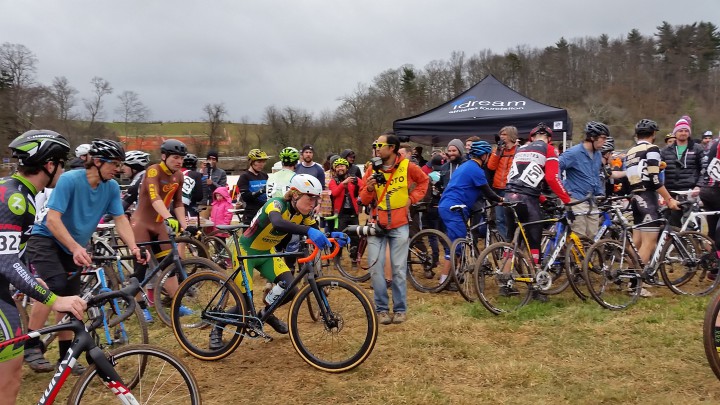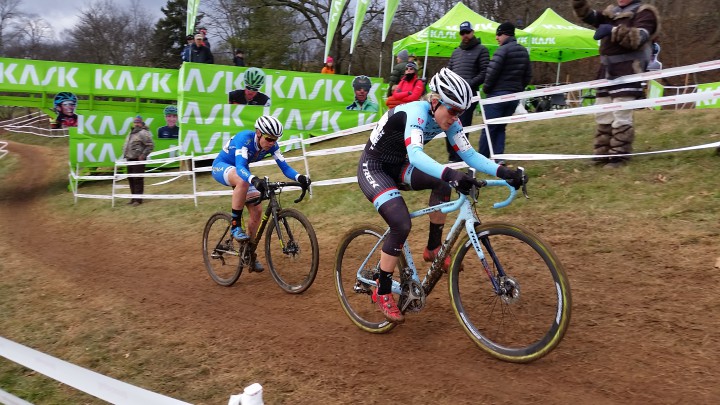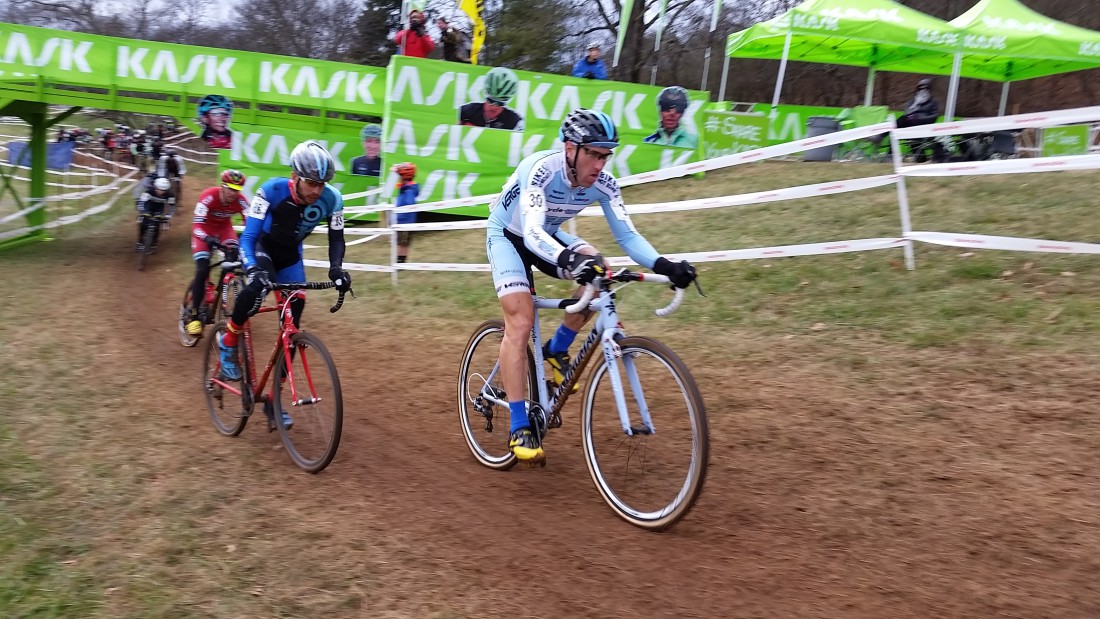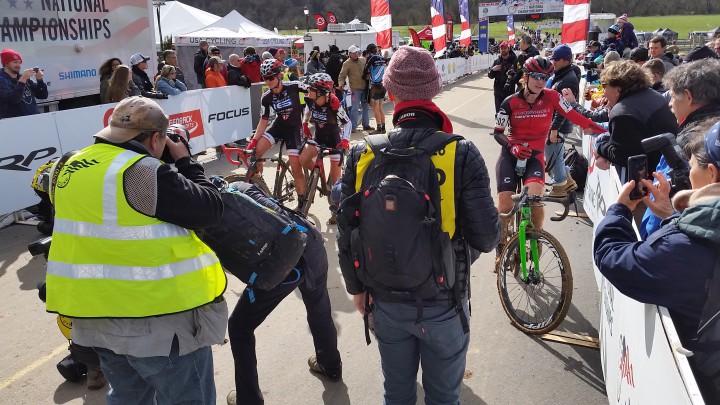As cyclists zipped around the often muddied and frozen course on the Biltmore Estate during the 2016 Cyclocross National Championships, Jan. 5-10, both racers and organizers had their fingers crossed that this year’s championships would differ from last year’s nationals, held in Austin, Texas. That event had been brought to a screeching halt after complaints were filed about the races being held in a public park containing heritage trees whose root systems faced possible damage from the racers. On Sunday morning, the finale of the week-long event, police blocked the gates, turning away both competitors and spectators on the day the pro races were scheduled to run. Everything was put on hold and threatened with cancellation while authorities negotiated. In the end, the races took place, but on Monday, which posed a logistical nightmare: Many athletes had departed, leaving only those who had been able to reschedule flights and hotel bookings. Spectator attendance tumbled.
The 2016 nationals proved that Asheville could successfully host a world-class cycling event that brought thousands of fans and racers into the Blue Ridge Mountains and exposed them to Southern culture, the micro-brew capital of the Southeast and Western North Carolina’s amazing cycling trails and roads. The event brought in top professional cyclists in search of the area’s best roads and most difficult trails, with many heading to Pisgah and Dupont national forests to challenge themselves against some of the best terrain the nation has to offer.
Tim Hopkin, creator of the North Carolina Cyclocross Series and the visionary behind this year’s Nationals course, began promoting races 20 years ago. Hopkin, who directs the Henderson County Parks and Recreation Department, says course’s unique venue, provided by Biltmore Estate, allowed him more freedom and assurance of the event’s success than organizers had last year in Austin, at Zilker Park. He began planning the course three years ago, while he was organizing regional trial races in preparation for Asheville’s nationals event. The Estate, Hopkin explained, “was very responsive and receptive to allowing us to build the course like we needed to and run the event to the standard that we did. They were a great venue and very cordial and hospitable.”

When issues become non-issues
The Biltmore’s venue was unique in another way: Everyone interested in racing or watching the events would be required to pay a $15 admission fee. It’s unusual at non-European cyclocross races to pay fees in addition to race registration, and so the admission fee became a point of contention for some. Micah Pulleyn, a Buncombe County Sports commissioner who helped organize volunteers for the event, says the Estate gave the event a very generous deal on entry fees, considering how deep a discount $15 is from the normal price of entry to the Estate. It allowed racers entry to the Estate grounds for the entire week and, by paying a small upgrade fee, racers could also visit the Biltmore House.
“People were very apprehensive,” Hopkin said, adding, “I think once they actually realized exactly how the whole process was going to work and the value of what they got being on the Biltmore Estate, I think a lot of those fears were quickly erased.”
In the end, the fee did not pose logistical problems such as long queues. Traffic wasn’t much of an issue until the end of each day, when attendees flooded out of the Estate. Adam Myerson, a 30-year-veteran bike racer and pro from New England, both defended and praised the 2016 nationals on his Twitter account, stating, “Nationals course evaluation: best nats course I’ve ever ridden. Maybe best U.S. course ever, period. Worth whatever line you have to wait in.”
As the 2016 cyclocross nationals approached, the Austin events weighed heavily on the minds of many athletes across the nation making the trek south to the Blue Ridge mountains. In the weeks leading up to what would be Asheville’s triumph, social media was ablaze with questions and concerns. The event plan required racers and visitors to the Biltmore Estate to share parking just outside Antler Village. Racers, especially those competing in national championship-level events, travel with a lot of equipment: multiple bikes, extra wheels, as many tires as possible, warm-up equipment, extra clothes and tools. Many expressed concern when they were told they would have to park three miles from the course. To accommodate their needs, organizers created a drop-off point near the course for racers.
But even with the drop-off feature, race attendees still had to take a shuttle 3 miles back to the course. And only pro racers were provided course-side parking for their team trailers. Once racers made their way back to their course-side set-up, they still had to get ready to race, which entails a myriad of tasks including warming up. Beginning a race cold and/or wet is always a concern in racers’ minds as it is a quick path to sickness. Asheville organizers took steps to mitigate these concerns — providing a large heated tent as near the start line and sufficient porta-johns to keep bathroom lines short. And Sycamore Cycles, located in Hendersonville and Brevard, organized the week-long volunteer-run drop-off zone.
Parking did not become a serious issue — racers and Estate guests (nonrace-goers) managed to share the Estate’s recently enlarged parking areas — until the weekend when the pros raced, and especially on Sunday, which was one of the coldest and only snowy days of the event. Apparently, Sunday’s bone-chilling wind didn’t deter event spectators, but encouraged them instead.
High praise and great challenge
Challenge can bring out the best in an athlete, and cyclocross offers plenty. Nonracers are unlikely to be familiar with the fire of lactic acid racers feel when charging up a slippery hill with their bike slung across their shoulder. The course Hopkin designed not only had a lot of elevation gain and multiple run-ups, it also featured some of the most difficult descents and chicanes that racers face throughout a season of cyclocross (September-February). A spectator favorite was Cane Creek Woods, which featured riders descending across terraced goat paths and riding down a short but quick drop into a chute with roots and abrasive bumps to had to be avoided. A majority of the week’s heckling occurred where the riders hit the drop — which, coincidentally, was almost everyone was crashing.
Video by Noah Bell. Cyclocross Nats. Go.
The course changed frequently with use and the weather. It was frozen and bumpy in the beginning of the week, changing to slippery in the mornings later in the week as temperatures warmed to 45-55 degrees. It was windy throughout, which caused quick course evolution, even from lap to lap, with certain sections becoming increasingly dry, with traction improving as the days unfolded. Cyclocross competitors typically race on a 1-mile track for 40 minutes to an hour, completing as many laps as time allows. Hopkin balanced the variety of terrain with fast, sustained power sections and technical, punchy, short power sections — features that generated much praise. Richard Fries, a well known commentator for top-level cyclocross events, exclaimed his approval on Twitter, “Wow. Greatest course in US CX history #cxnats. Get your popcorn ready!”
Local superstars, supporters and volunteers
It was Buncombe County Regional Sports Commission Executive Director Ben VanCamp who originally approached Hopkin with the idea of Asheville hosting the cyclocross nationals. Ever since then, VanCamp has been integral part of the nationals coming together. Among his roles, he oversaw the vendor-expo area, where local sponsors tents set up, including Sycamore Cycles, Cane Creek, Industry Nine Components, Suspension Experts and Ingles.
Keegan Schelling, one of USA Cycling’s chief course designers, oversaw the course design, as well as heading up its volunteer-based construction. It couldn’t have been done without Asheville’s volunteer spirit, say Hopkin and VanCamp. “The overall community support and people coming out of the woodwork to lend a hand, I can’t say enough about those volunteers,” exclaimed VanCamp. “There’s folks in that group that had their own personal business and shut it down for two weeks to be out there everyday, all day, 12 hours a day. One person I know in particular had to take a week off with no pay. She’s a school teacher; they don’t get much in the way of vacation time, so she just said [to the school], ‘don’t pay me for the week’ and came to help at the course. That core group was some of the best people I’ve ever had the pleasure to work with for sure,” he added.
Pulleyn voiced similar exuberant praise on her social media, saying, “I feel incredibly honored to be a part of such a powerhouse of a team! When I think of this event, I am so moved by all the people who came out to make it happen — from the core team, to the hundreds of volunteers.”
“We were able to work with the local Outdoor Gear Builders Association, which is something we’re really proud of,” VanCamp added. Sierra Nevada was one of USA Cycling’s biggest sponsors and supported the event by donating a significant part of its event beer-sales proceeds to the Carolina Mountain Land Conservancy. By Sunday, every can of beer at the event had been sold, Hopkin said. The brewery was particularly excited to have such a large-scale event nearby its newest facility in Mills River.
Sierra Nevada hosted the first-ever mechanics nationals on Friday, in which 20 professional mechanics were pitted against each other to see who could repair or build a bicycle the fastest. Other nonrace events included a party or benefit every night of the six days of racing. The GiddyUp Film Tour Asheville Premiere led things off on Wednesday, Jan. 6, with proceeds benefiting the Amy D. Foundation, which encourages and empowers young female cyclists; Liberty Bicycles hosted a party where pros Katie Compton, winner of the elite women’s race, and Adam Myerson handed out raffle prizes. Saturday featured a junior’s party. And the week ended with a crescendo on Sunday at Asheville’s Foam Party. Named in honor of Louisville’s infamous sans-foam Foam Party at the first-ever world cyclocross championships in the United States in 2013, Asheville’s version, organized by Megan Archer, raised $2,000 for Trips for Kids, an organization that helps disadvantaged kids get out and bike.
A crossing of cultures
LeeAnn Donelly, senior public relations manager at the Biltmore Estate said, “Roughly 5,000 spectators and race participants were on the Estate. We were delighted with the outcome [of the event], and [the nationals crew] were a great group to work with. Hopefully we’ve exposed people to the Estate who may not have necessarily come to visit us.”
Many nonrace-goers were intrigued by the excitement and intensity of the race, Hopkin noted. Both Hopkin and VanCamp had hoped not only to put on a stellar event, but also to raise awareness of the sport to the public. “There were a lot of people there just to check out the Biltmore House that just stumbled upon the race. There’s a lot of people that just happened to be visiting the Biltmore House and the Estate that stumbled upon [the race] and checked it out for a while,” VanCamp recalled. “There were a lot of people there experiencing cyclocross for their first time. I gave the cyclocross 101 talk a few times.”
Cyclocross is one of the fastest growing disciplines of cycling in the U.S. The sport enjoys huge support in Europe, where cyclocross races draw as many viewers as NFL football does in the U.S., according to the Associated Press.
2016 Cyclocross Nationals turned out to be a greater success than anticipated, as evidenced in the high praise from volunteers and the ‘big-hitters’ like Pulleyn, Laura Rice (the event’s communications director), Hugh Moran (chief volunteer coordinator) and many others involved in the course construction and logistics. “It was like Walt Disney meets cyclocross, and everyone really enjoyed themselves,” wrote Jeremy Powers, a four-time national title holder, describing the Biltmore Estate venue. Powers is the newly crowned elite men’s national champion. Powers continued, “I think Tim Hopkin — the race organizer — USA Cycling and everyone who had a part in it deserves a huge pat on the back because it was a really well run and well executed National Championships.”
Back when Hopkin first began promoting local and regional cyclocross events, he told those working with him he wanted to host a national championship. It may have been his long-lived dream, but Hopkin is adamant about highlighting all those who sweated and made sacrifices to make the event what it was. Hopkin agreed it was great an effort to pull off an event of this magnitude, but he emphasized, “It wasn’t a one-man show. There was a vision there … and that vision was sort of translated by everyone else who were going to step up and believe in what I thought nationals could be.”

A dream brought to reality
“It was such a highly-rated venue and course that it was deemed worthy of using for a future bid for the World Championships,” Hopkin said, based on feedback he received from not only racers, but also from Micah Rice, vice president of National Events for USA Cycling. “I think that’s a great honor and testament to all the hard work that we put in.” Hopkin’s new dream, now that the nationals are over, is to host the world championships in Asheville, if given the go-ahead by USA Cycling, the Biltmore Estate and the UCI, cyclocross’ international governing body. Rice said on Twitter that Asheville’s cyclocross national championships drew a record-breaking 1,808 unique racers during the six days of racing.
Go here to see a recap of the weekend’s pro races in Asheville.
And while the 2016 cyclocross nationals were a big success, the biggest race of the year, the world championships, takes place Jan. 31 in Huesden-Zolder, Belgium. Live feeds will be available online on European networks.
Joshua Cole served as a volunteer for the 2016 cyclocross nationals and has raced cyclocross since 2011. He competed throughout this year’s week-long nationals for both Haywood Road Cx and Brevard College cycling teams.





Great article but failed to mention that proceeds from Sierra Nevada beer sales were split between CMLC and Mills River Partnership, a watershed protection organization.